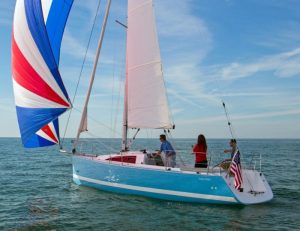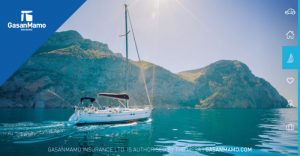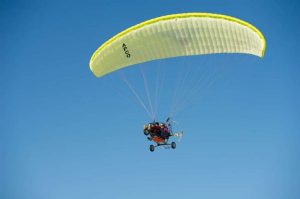Embark on a thrilling journey through Solo sailing adventures, where the vast ocean becomes your playground and the wind guides your way. Discover the allure of sailing solo, from essential tips to must-have skills, in this captivating exploration of the open seas.
Get ready to set sail on a solo escapade like no other, as we navigate through the vast expanse of the ocean, sharing insights and stories that will ignite your sense of adventure.
Solo Sailing Adventures
Solo sailing adventures offer a unique and exhilarating experience for those who crave freedom, challenge, and solitude on the open seas. The appeal of setting sail alone lies in the opportunity for self-discovery, personal growth, and the ultimate test of one’s sailing skills and seamanship. Whether crossing oceans or exploring coastal waters, solo sailors find a sense of independence and empowerment that is unmatched in any other type of sailing journey.
Preparing for a Solo Sailing Trip
Embarking on a solo sailing trip requires meticulous planning, preparation, and a keen sense of self-reliance. Here are some essential tips to consider before setting sail alone:
- Ensure your boat is in top condition and thoroughly inspected.
- Plan your route carefully, considering weather patterns, currents, and potential hazards.
- Stock up on essential supplies, including food, water, safety gear, and communication devices.
- Brush up on your navigation and sailing skills to handle any challenges that may arise.
- Create a detailed float plan and share it with a trusted person ashore.
Comparison: Solo Sailing vs. Sailing with a Crew
Solo sailing and sailing with a crew offer distinct experiences and challenges. While sailing with a crew allows for shared responsibilities, camaraderie, and support, solo sailing demands self-sufficiency, decision-making autonomy, and a deeper connection with the sea. Solo sailors must rely solely on their own skills, intuition, and resourcefulness, making every accomplishment and setback a truly personal journey.
Essential Skills for Solo Sailing
To thrive in the world of solo sailing, one must possess a unique set of skills that go beyond basic sailing knowledge. Some essential skills for solo sailing include:
- Advanced navigation skills using charts, GPS, and celestial navigation.
- Mechanical aptitude to troubleshoot and repair boat systems on your own.
- Emergency response training to handle crises at sea effectively.
- Mental resilience to cope with isolation, fatigue, and unexpected challenges.
- Physical fitness to endure long hours of sailing and perform tasks on deck in varying conditions.
Cycling & Bikepacking Travel
Cycling and bikepacking travel both involve exploring destinations on a bicycle, but there are some key differences between the two. Cycling typically refers to road biking or mountain biking on paved or unpaved roads, while bikepacking is a form of off-road cycling that includes carrying all necessary gear on the bike for self-supported travel over longer distances.
Benefits of Exploring Destinations Through Cycling
Cycling offers a unique way to experience a destination up close and personal. It allows travelers to cover more ground than walking while still being able to stop and take in the sights along the way. Cycling also provides a sense of freedom and adventure, allowing travelers to explore off-the-beaten-path locations that may not be accessible by car.
Popular Cycling Routes for Adventurous Travelers
- The Pacific Coast Highway: Known for its stunning coastal views, this route runs along the Pacific coastline from Canada to Mexico.
- The Great Divide Mountain Bike Route: This challenging off-road route stretches over 2,700 miles from Canada to Mexico, crossing the Continental Divide multiple times.
- The Danube Cycle Path: Following the Danube River through Europe, this route offers picturesque landscapes, charming villages, and historic landmarks.
Essential Gear Needed for a Bikepacking Trip
- Bikepacking Bags: Specially designed bags that attach to the bike frame, handlebars, and seat post to carry gear and supplies.
- Tent and Sleeping Bag: Lightweight and compact camping gear for overnight stays along the route.
- Cooking Supplies: Portable stove, fuel, and cookware for preparing meals while on the road.
- Navigation Tools: GPS device or maps to navigate the route and find campsites or accommodations.
- Repair Kit: Tools, spare parts, and tire repair supplies to handle any mechanical issues that may arise during the trip.
Road Trips & Van Life Travel
Road trips and van life travel both offer unique experiences for adventure seekers looking to explore the open road. While road trips provide the flexibility to travel in any vehicle, van life travel offers the opportunity to create a customized living space on wheels. Let’s delve into the comparison between these two travel styles.
Comparing Road Trips and Van Life Travel
- Road trips allow for spontaneous travel decisions and the freedom to choose different accommodations along the way.
- Van life travel provides a consistent living space with the convenience of having all necessities on board.
- Both road trips and van life travel offer the chance to immerse oneself in nature and explore off-the-beaten-path destinations.
Tips for Converting a Van into a Livable Space
- Maximize storage space by utilizing overhead compartments and under-bed storage solutions.
- Consider installing a solar power system for off-grid living and charging electronic devices.
- Create a comfortable sleeping area with a quality mattress or foldable bed platform.
Freedom and Flexibility of Road Trips
- Road trips offer the freedom to change routes, destinations, and timelines according to personal preferences.
- Exploring different scenic routes and stopping at roadside attractions adds spontaneity to the journey.
- Flexibility in accommodation choices allows for a diverse range of lodging experiences, from campsites to cozy motels.
Challenges of Long-Term Van Life Travel
- Limited living space in a van can pose challenges in terms of storage, organization, and overall comfort.
- Maintaining a sustainable lifestyle with water, food, and waste management requires careful planning and resourcefulness.
- Finding suitable parking spots for overnight stays, especially in urban areas, can be a challenge for van dwellers.
Rock Climbing Travel
Rock climbing is an exhilarating outdoor activity that allows adventurers to challenge themselves physically and mentally while enjoying breathtaking views from unique vantage points. The thrill of scaling towering cliffs, navigating challenging routes, and conquering difficult terrains makes rock climbing a popular choice for travelers seeking adrenaline-pumping experiences in stunning natural settings.
Outdoor vs. Indoor Rock Climbing
Indoor rock climbing, often done in climbing gyms, provides a controlled environment for enthusiasts to practice and improve their climbing skills. It offers a consistent setting with artificial holds and routes, making it ideal for beginners and experienced climbers alike to train and stay active. On the other hand, outdoor rock climbing offers a more unpredictable and adventurous experience, as climbers must contend with varying weather conditions, natural rock formations, and the thrill of exploring new locations.
The sense of accomplishment and connection to nature that outdoor climbing provides cannot be replicated in an indoor setting.
Safety Tips for Rock Climbing Travel Adventures
Always check and double-check your gear before starting a climb.
Stay hydrated and energized throughout your climb to maintain focus and strength.
Communicate effectively with your climbing partner or group to ensure a safe and enjoyable experience.
Be mindful of your surroundings and follow proper climbing techniques to minimize risks of accidents.
Respect the environment and leave no trace to preserve the natural beauty of the climbing locations.
Mental and Physical Benefits of Rock Climbing
Rock climbing is not only a physically demanding activity but also a mental challenge that promotes problem-solving skills, focus, and determination. The need to strategize and adapt to changing conditions while climbing helps improve cognitive functions and mental resilience. Additionally, the full-body workout that climbing provides helps strengthen muscles, improve flexibility, and enhance overall fitness levels.
The sense of achievement and confidence gained from successfully completing a challenging climb can have a positive impact on mental well-being and self-esteem.
Extreme Sports Travel
Extreme sports travel is an exhilarating way to explore the world while pushing your limits and experiencing the thrill of adrenaline-pumping activities.
Popular Extreme Sports Destinations
- Hawaii, USA: Known for big wave surfing and volcano boarding.
- Interlaken, Switzerland: Offers skydiving, bungee jumping, and paragliding.
- Queenstown, New Zealand: Home to bungee jumping, skydiving, and jet boating.
Adrenaline Rush in Extreme Sports
Extreme sports provide a rush of adrenaline that can be addicting, offering a sense of freedom and excitement unlike any other. The combination of fear and excitement creates a unique experience that is hard to replicate.
Personal Experiences in Extreme Sports Travel
- Paragliding in the Swiss Alps was a breathtaking experience, soaring above majestic mountains and crystal-clear lakes.
- White-water rafting in Costa Rica was both thrilling and challenging, navigating through rapids surrounded by lush rainforests.
- Rock climbing in Thailand offered stunning views from the top of limestone cliffs, a test of both physical and mental strength.
Importance of Training and Safety Measures
Proper training and safety measures are essential in extreme sports to minimize risks and ensure a safe and enjoyable experience. Whether it’s learning the correct techniques or using quality gear, preparation is key to preventing accidents and injuries.
Sailing & Boating Travel

Sailing and boating travel offer unique experiences that allow travelers to explore the world from a different perspective. Whether sailing on a small boat or a large yacht, each type of vessel provides its own set of thrills and challenges.
Sailing on a Small Boat vs. Large Yacht
When sailing on a small boat, travelers often experience a more intimate connection with the sea and nature. The close quarters and hands-on approach required for maneuvering a small boat create a sense of adventure and independence. On the other hand, sailing on a large yacht offers a more luxurious experience with spacious accommodations and amenities. The focus shifts from navigating the boat to enjoying the comfort and leisure that a large yacht provides.
Cultural Significance of Sailing
Sailing holds significant cultural importance in various regions around the world. In places like the Mediterranean, sailing is deeply intertwined with the local lifestyle, traditions, and history. In Polynesian cultures, sailing represents a connection to ancestors and a way of life that has been passed down through generations. Understanding the cultural significance of sailing in different regions can enhance the travel experience and provide insights into local customs and beliefs.
Memorable Sailing Adventures
- Exploring the Greek Islands on a traditional wooden sailboat, witnessing stunning sunsets and discovering hidden coves.
- Sailing along the coast of Croatia, visiting medieval towns and sampling local cuisine in picturesque harbors.
- Crossing the Atlantic Ocean on a sailing yacht, experiencing the vastness of the open sea and the thrill of reaching a new continent.
Environmental Impact of Boating Travel
Boating travel can have various environmental impacts, including water pollution, disturbance of marine life, and carbon emissions. To minimize the environmental impact of boating travel, travelers can opt for eco-friendly vessels, reduce fuel consumption, properly dispose of waste, and support marine conservation efforts. By taking proactive steps to protect the marine environment, boating enthusiasts can enjoy sailing experiences responsibly and sustainably.
Ultimate Conclusion

As we dock our ship of knowledge on the shores of wisdom, remember that Solo sailing adventures are not just about conquering the seas but also about conquering your fears and embracing the unknown. So, hoist your sails high and let the winds of exploration carry you to new horizons. Fair winds and following seas await!
Question & Answer Hub
What makes solo sailing adventures so appealing?
Solo sailing adventures offer a unique sense of freedom and self-reliance, allowing you to challenge yourself and explore the world at your own pace.
How can I prepare for a solo sailing trip?
Ensure you have proper safety equipment, navigation skills, and a well-equipped boat before embarking on a solo sailing adventure.
What essential skills are needed for solo sailing?
Key skills include navigation, seamanship, emergency response, and the ability to handle the boat in various weather conditions.




